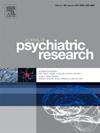调查精神分裂症患者基于位置和基于对象的返回抑制
IF 3.7
2区 医学
Q1 PSYCHIATRY
引用次数: 0
摘要
返回抑制(IOR)在注意定向任务中具有明显的效应。相比于一个新的地点,人们在发现最近去过的地点出现的目标时速度更慢,或者更不准确。有时,抑制可以减缓对特定对象的注意力回归(基于对象的IOR)。基于对象的IOR已经在动态和静态显示中得到了演示。在静态显示中,基于对象的IOR可以添加到基于位置的IOR中。调查精神分裂症患者IOR的研究产生了相互矛盾的结果。到目前为止,还没有研究对精神分裂症患者进行基于客体的IOR检查。目前的研究使用线索回到固定外源性线索范式与静态显示来调查精神分裂症患者和健康对照中基于位置和基于对象的IOR。结果显示,两组均发生了明显的基于位置的IOR,患者组的IOR程度低于对照组。两组均未观察到附加的基于物体的IOR。此外,患者的IOR与他们的年龄、教育程度和症状严重程度无关。然而,IOR可能与他们的一般认知功能有关。总的来说,研究结果支持了基于位置的IOR在促进视觉搜索的抑制机制中发挥更重要作用的假设。本文章由计算机程序翻译,如有差异,请以英文原文为准。
Investigating location-based and object-based inhibition of return in patients with schizophrenia
Inhibition of return (IOR) is a well-observed effect in attention orienting tasks. People are slower and/or less accurate to detect a target that appeared at a recently attended location than a novel one. Sometimes inhibition can slow the return of attention to a particular object (object-based IOR). Object-based IOR has been demonstrated in both dynamic and static displays. In static displays, presumably object-based IOR can be additive to location-based IOR. Research investigating IOR in patients with schizophrenia have yielded conflicting results. To date no study has examined object-based IOR in patients with schizophrenia. The current study used a cue back to fixation exogenous cuing paradigm with static displays to investigate both location-based and object-based IOR in patients with schizophrenia and healthy controls. The results showed that significant location-based IOR occurred in both groups, with reduced magnitude of IOR in the patient group than in the control group. No additive object-based IOR was observed in either group. Furthermore, IOR in patients did not correlate to their age, education, and symptom severity. However, it is possible that IOR is related to their general cognitive function. Overall, the results support the hypothesis that location-based IOR plays a much more essential role in the inhibitory mechanisms that facilitate visual search.
求助全文
通过发布文献求助,成功后即可免费获取论文全文。
去求助
来源期刊

Journal of psychiatric research
医学-精神病学
CiteScore
7.30
自引率
2.10%
发文量
622
审稿时长
130 days
期刊介绍:
Founded in 1961 to report on the latest work in psychiatry and cognate disciplines, the Journal of Psychiatric Research is dedicated to innovative and timely studies of four important areas of research:
(1) clinical studies of all disciplines relating to psychiatric illness, as well as normal human behaviour, including biochemical, physiological, genetic, environmental, social, psychological and epidemiological factors;
(2) basic studies pertaining to psychiatry in such fields as neuropsychopharmacology, neuroendocrinology, electrophysiology, genetics, experimental psychology and epidemiology;
(3) the growing application of clinical laboratory techniques in psychiatry, including imagery and spectroscopy of the brain, molecular biology and computer sciences;
 求助内容:
求助内容: 应助结果提醒方式:
应助结果提醒方式:


